Brushes carry our paint from the palette to the canvas. They give us control over our marks and assist us in handling paint and mediums. Therefore, brushes are an important tool for any painter and worth looking into deeper. At GOLDEN, we produce paint in three different mediums: oils, acrylics, and watercolors. Not every brush is suited for every medium, though. Here we want to explore which brush types are best suited for the respective mediums.
We will talk about:
- Parts of a brush
- Desired features of a brush
- Our brush recommendations for watercolor, acrylic and oil painting
- Pros and cons of natural and synthetic hair
- Natural brush head materials
- Synthetic hairs
- Brush care
-
Parts of a Brush
Let’s start with the parts of a brush. Understanding how a brush is constructed informs us about its quality, durability, and important aspects of brush care. The length of the brush handle varies for different uses. Most watercolor brushes have short handles because watercolorists usually paint small scale and sit right in front of their work, while oil and acrylic brushes can have either short or long handles, so that one can stand back a step while painting and keep an overview of the entire composition. The ferrule secures the brush hair at the hair’s heel to the handle and the more crimps a ferrule has, the sturdier its construction. Inside the ferrule, the brush hairs are glued together into a bundle with vinyl or epoxy resin adhesive. The brush hairs or bristles constitute the head or tuft of the brush, which has a belly in the middle and a tip. The hairs in the tip are the longest and must be particularly strong.

-
Desired Features of a Brush
There are some features that are desirable for any paintbrush, regardless of the type of paint one chooses. A brush should:
- Maintain its performance and retain its shape despite daily use.
- Have good paint holding capacity and paint release.
- Have elastic and strong hairs/fibers/bristles, a quality referred to as spring or snap.
- Be responsive to our hand, technique, and to the surface it touches.
- Be chemically resistant, to allow for cleaning with solvents.
A reliable way to assess the quality of a brush, especially when purchasing a costly sable brush, is to rinse the brush in water to remove the stiffening size. When bending the hairs, they should always spring back into position and recover their original shape.
-
Our Brush Recommendations for Watercolor, Acrylic and Oil Painting
As a rule of thumb, we recommend having dedicated brushes for each painting medium. If switching between mediums, the brushes may not last as long and tend to lose their desired qualities. A watercolor brush, for instance, once used with oil or acrylics, will usually not perform as desired anymore for watercolor painting.
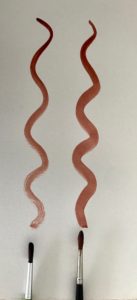
- Watercolor brushes: Good quality synthetic brushes are fine for water coloring, but they are not equivalent to good quality natural hair brushes in terms of paint control, especially in the way they release paint. Synthetic brushes tend to absorb less water, which can make watercolor gather excessively at the tip and run quickly off the brush, onto a more absorbent paper surface (Image 2). There are big quality differences among natural hair brushes, with Kolinsky sable brushes being the crème de la crème. There are also good blends of synthetic and natural fibers. Generally, a good synthetic filament is better than a poor quality red sable.
- Acrylic brushes: For acrylic painters we recommend using synthetic brushes, particularly due to their chemical resistance. Acrylic dispersion paints have a high pH and the alkalinity damages natural hair, which makes them break easier. Acrylic dispersion paints also contain ingredients that strip natural hair of its natural oils, causing the hair to become brittle. Thicker paint like Heavy Body can be easier to manipulate with stiff polyester brushes that have a good snap (i.e. stiff but elastic), while smooth applications with Fluid, High Flow and the relatively soft bodied OPEN Acrylics can be easier to achieve with soft nylon brushes.
- Oil brushes: Both natural and synthetic brushes can be used for oil painting. Natural hog bristle brushes are great because they have good stiffness and can hold more paint than synthetic brushes could. Thus one brush load of paint goes a longer way and one is not required to pick up more paint all the time. Especially thicker impasto painting requires stiffer bristle brushes. For fine details and glazes, red sable brushes or soft synthetic hair brushes with good spring are great.
Recommendations for varnishing brushes can be found here.
-
Pros and Cons of Natural and Synthetic Hair
Both synthetic and natural hair have their advantages and disadvantages. Where natural hair brushes excel is in their capacity to hold water and paint and in the evenness of the paint release. However, natural hair tends to break easier and could leave hairs behind on the painting, which is called shedding. Albeit poorly made, synthetic brushes might also shed hairs if the hairs no longer hold fast in the ferrule. Natural hair brushes also tend to be more expensive than their synthetic imitations. Synthetic hair brushes have greater chemical resistance and are therefore more suitable for acrylic dispersion paints, which have an alkaline pH due to the ammonia pH buffer. They also work well for varnishes and lacquers that require strong solvents for brush cleaning. Synthetic hair is slicker, which reduces its ability to hold paint and may not deliver the same painting experience as the ‘real’ thing. To get the best of both worlds, one can try blends of natural and synthetic hairs. Last but not least, there is the ethical issue of using animal hair brushes. Animals used for paintbrushes suffer in many of the same ways as animals used for fur coats and the vast majority of brush hair comes from China and Russia, where laws to protect animals are either nonexistent or unenforced. Synthetic hair brushes are thus a cruelty-free alternative.
-
Natural Brush Head Materials
The fascinating thing about natural hair brushes is the uniqueness of each hair type depending on its origin. Nothing could ever compare to the ingenuity, uniqueness and intricacy with which Mother Nature equips animals in their furs.
Sable hair
Sable brushes can be made from the hair of weasels, minks, ermines, martens, or kolinskies. Natural sable imitations, often labelled sabeline, can be made of squirrel, dyed ox hair, Russian fitch hair, goat, badger, or American skunk. The finest and most precious of all sable brushes are made from the Siberian kolinsky, particularly from guard hairs from the tail of male winter pelts. These animals do not fair well in captivity and it’s only the wild ones which produce the longest and thickest hairs, needed to survive the Russian winters.
The anatomy of the sable hair is fascinating. It has a flowing curved shape with a thick belly and a very fine tip. In a paint brush, the ferrule holds the hairs just below the belly, which allows for maximum elasticity and snap. This belly helps push the hairs apart in the brush, which opens gaps for water to cling to the hairs. The curve of the hair gives sable brushes, furthermore, exceptional ability to be finely shaped. The surface of sable hair is covered in microscopic scales, the so called spinous cuticle scales that are formed like petals and oriented towards the hair tip. These scales allow sable hair to absorb and hold a lot of water or paint.
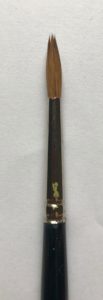
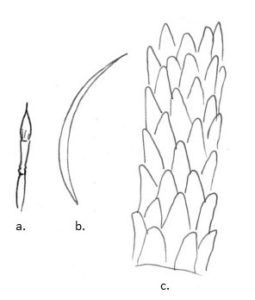
Hog bristles
The difference between hair and bristle is that the ends of bristles split up into a handful of tips, the so-called flag, while hairs have a single tip. Bristles have a natural curve, which is reduced somewhat by boiling. This curve is taken advantage of by interlocking fibers during assembly, so that the curved bristles oppose one another and curve towards the center. Domesticated pigs have less bristles and their bristles have less flag. Today’s bristles come mainly from Chinese hogs and the best quality ones come from their neck and along their spine. The surface of hog bristles is covered in so-called imbricate scales, which consists of overlapping scales with narrow margins, also commonly found in human hairs.

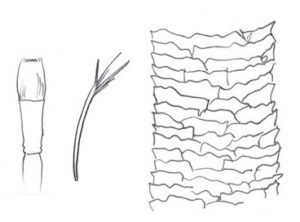
Ox hair
Cow or ox hair is taken from the ears (auricles) of the cattle. These hairs are cylindrically shaped and don’t form a fine point like sable hair does. Ox hair is very long, strong, inexpensive, and has appealing elasticity, which makes it great for rougher brush techniques. Ox hair is often blended with hog bristles or inexpensive sable, to give the ox hair brush heads better pointing capability.
Squirrel
Hair from squirrel tails is called Fehair. It is very fine, soft, absorbent, and not springy, making it suitable for the production of mops, flats, filberts, and wash brushes, which must hold a lot of water.

-
Synthetic Hairs
The imitation of natural hair with synthetic filaments, particularly nylon and polyester, is a growing and fast developing field as natural hair is becoming scarcer. Challenges are the topography of fiber surfaces and the shape of fibers. Improvements have been made to increase their capacity to carry more water and paint by roughening the hair’s surface, although synthetics still don’t equal natural hair’s load holding capacity. In comparison to natural hair, synthetic hairs are much straighter in form, which doesn’t open gaps so the bundle of hairs holds less water and might release it differently. For bristle imitations, the ends are mechanically tipped to reproduce the flag. With fine hair imitations, fibers are tapered, which makes these synthetics retain their shape better. Filament surfaces are often roughened by abrasion, or etching to increase paint-carrying ability and are additionally dyed and baked to make them softer and more absorbent.
The most common type of polyester used for brushes is PBT (polybutylene terephthalate), which offers many of the same properties as nylon, but absorbs less water. This allows PBT to hold its stiffness in wet applications. Nylon/polyester blends combine the positive qualities of nylon, which is precise tipping, excellent paint pickup, and smooth finish and of polyester, which is added stiffness and control.

-
Brush Care
It’s never good to let brushes soak in water or solvents, as that will make the bristles lose their shape, the ferrules can come lose and in the case of harsh solvents, it can dissolve the adhesive within the ferrule, which is gluing the hairs together.
Watercolor brushes are best cleaned by rinsing in plenty of water, although some staining colors such as Phthalos might require some mild soap to clean completely. Be sure to be gentle with any cleaning and rinse all of the soap from the brush before painting. Allow the watercolor brushes to dry with nothing touching the tip and if the handle is wood, avoid letting the brush dry upright, as that might encourage water to drain into the wood, swell it and ultimately, make the ferrule come lose. It helps to clean acrylic brushes with soap from time to time and to brush out paint that has collected at the heel of the brush with a dedicated nail scrubber. For “heeled up” brushes with dried paint in the hairs, products such as the Masters Brush Cleaner can be great. Oil brushes should be wiped clean as much as possible with cotton rags or paper towels and then cleaned with mineral spirits or with drying oil such as linseed, as described in Cleaning Brushes Without Solvents. When using linseed oil for brush cleaning, the brushes have to be cleaned additionally with a mild soap and lukewarm water after the painting session. Using oil to clean brushes is an aged-old technique and the dirty oil, which one ends up with, has the perfect soupy-brown color for creating colored oil grounds or painting the imprimatura. It is important that the brushes are never exposed to solvents for too long, as the adhesive used to bundle hairs/bristles in the ferrule, can be sensitive to strong aromatic solvents. When storing away natural hair brushes for longer periods, place mothballs nearby.
About Mirjam Auf der Mauer
View all posts by Mirjam Auf der Mauer -->Subscribe
Subscribe to the newsletter today!
No related Post

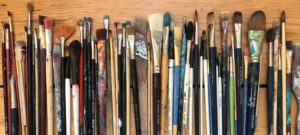
Gracias por esta importante información, para quienes amamos el buen arte.
Thank you. I’ve been looking for a comprehensive comparison of brush types. Now to sort mine. I’m a beginner and just buy whenever and whatever . . .
[url=https://vyvod24.ru/bolezn-alczgejmera/]Лечение болезни Альцгеймера в наркологической клинике Вывод24[/url]
Had an issue and Scott Bennett answered my email right away. So grateful and thankful for fast professional service. I have very little art experience, Golden heavy body are my first “real” paints. They are wonderful to work with! Thank you!
I am so glad we could help Dorothy! Enjoy painting.
Thanks,For such a wonderful information it would be really helpful
I’m somehow confused with “acrylic dispersion/emlusion/latex”
Does these mean all the same?
What exactly type/binder of artist’s common water-based acrylic paint is?
Hello Nourkias,
Thanks for your question. Artist acrylic paints are made from acrylic dispersions. GOLDEN products are 100% acrylic polymers.
House paints will often be called Latex paints, though there is no latex in these products. House paints for interior use may have some vinyl polymers mixed with acrylics to make them less expensive and to modify certain characteristics of the paint. Exterior house paints tend to be made from acrylic because they are more durable and hold up to the elements better. For most applications, synthetic, nylon bristle brushes are appropriate for all artist acrylics and house paints, size and shape would be determined by the application.
Hope this helps,
greg
Thanks,I understand.
Artist acrylic paints are made from acrylic dispersions (Soild particle in water?).
Not emlusion (Liquid oil-like stuff in water?).
And the word “Latex” is just another habitual name of “Acrylic Dispersion” used in house paint.
Though they may not be the same as artist’s ones.
The recommand is quite interesting.
Teacher usually recomand kolinsky sable brush is the best
(For miniature painting).
I will try synthetic ones later.
and from the article i see a word “ammonia pH buffer”
I use to see an article from Gamblin saying that
When acrylic dry, Ammonia & Propylene Glycol may slowly evaporate.
While teacher know nothing about the ammonia stuff.
I do smell alcohol-like and a little ammonia from certain paint prodict (Mainly slow-drying product) .
Does all artist acrylic paint has that (ammonia & propylene glycol)?
And does it matters?
The ammonia and PG are used to help stabilize the product for long term shelf life among other things. Also, to provide some beneficial working properties like open time etc. Both are volatile and will evaporate out of the film as the polymer coalesces. We do not recommend natural bristles like sable with acrylics, as the ammonia is hard on the hairs, will dry them out and ruin the brush! save those for your oil, tempera or watercolor…
take care,
Greg
Where can i buy a package of quality mix of brushes?
Hello John,
Thank you for your question. We do not know of any bundles of quality brushes, and recommend simply trying new brushes now and then and keeping a record of how well each brush works with your process and the paint medium being used. Your experience-based record can then create a foundation for future brush decisions. We hope this is helpful, and we are here when you have more questions.
Happy painting, Cathy